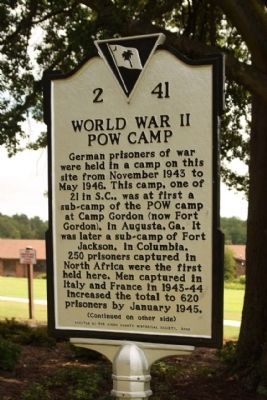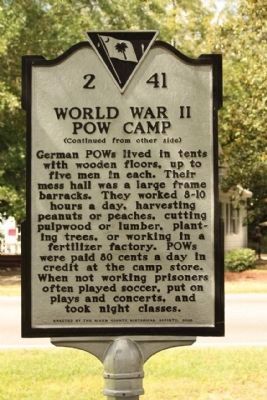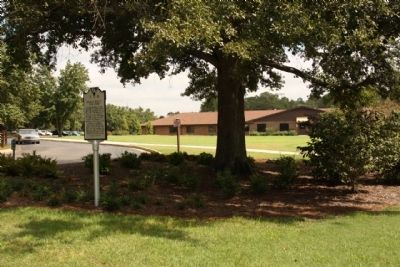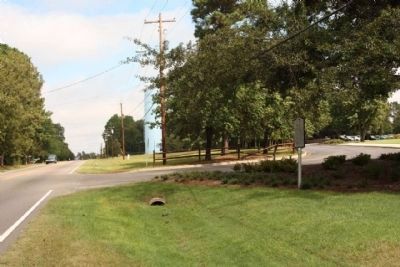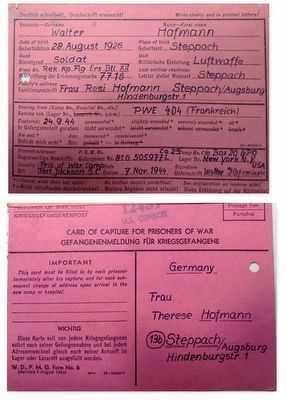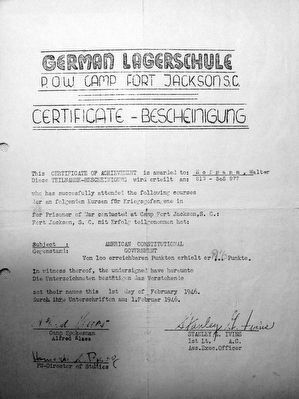Aiken in Aiken County, South Carolina — The American South (South Atlantic)
World War II POW Camp
German prisoners of war were held in a camp on this site from November 1943 to May 1946. This camp, one of 21 in S.C., was at first a sub-camp of the POW camp at Camp Gordon (now Fort Gordon), in Augusta, Ga. It was later a sub-camp of Fort Jackson, in Columbia. 250 prisoners captured in North Africa were the first held here. Men captured in Italy and France in 1943-44 increased the total to 620 prisoners by January 1945.
German POWS lived in tents with wooden floors, up to five men in each. Their mess hall was a large frame barracks. They worked 8-10 hours a day, harvesting peanuts or peaches, cutting pulpwood or lumber, planting trees, or working in a fertilizer factory. POWs were paid 80 cents a day in credit at the camp store. When not working prisoners often played soccer, put on plays and concerts, and took night classes.
Erected 2008 by Aiken County Historical Society. (Marker Number 2-41.)
Topics and series. This historical marker is listed in this topic list: War, World II. In addition, it is included in the South Carolina, Aiken County Historical Society series list. A significant historical month for this entry is January 1945.
Location. 33° 34.581′ N, 81° 43.222′ W. Marker is in Aiken, South Carolina, in Aiken County. Marker is on Laurens Street North West (State Highway 19) north of Jones Avenue, on the right when traveling north. Located Between Jones Avenue and Beams Road in front of Mattie C. Hall Health Care Center at driveway. Touch for map. Marker is in this post office area: Aiken SC 29801, United States of America. Touch for directions.
Other nearby markers. At least 10 other markers are within one mile of this marker, measured as the crow flies. Aiken Colored Cemetery / Pine Lawn Memorial Gardens (approx. 0.4 miles away); Aiken Vietnam War Monument (approx. ¾ mile away); Aiken Preparatory School (approx. 0.9 miles away); The Augusta And Aiken Railway (approx. 0.9 miles away); Adath Yeshurun Synagogue (approx. 0.9 miles away); First Presbyterian Church of Aiken (approx. 0.9 miles away); Aiken Graded School (approx. 0.9 miles away); Author Jeff Scott (approx. one mile away); Aiken Hospital / Aiken County Hospital (approx. one mile away); St. John's Methodist Church (approx. one mile away). Touch for a list and map of all markers in Aiken.
Regarding World War II POW Camp. Throughout the South-
Under the Geneva Convention they could not be forced to work, but some volunteered to harvest crops and work in sawmills. They had orchestras, elaborate theater productions and choruses.
About 3,600 were enrolled in a school taught by other prisoners. They were old enough and wise enough to make use of the time while they were here. When they went home, the German government gave them credit for the college-level courses.
Related markers. Click here for a list of markers that are related to this marker. Other POW Camps
Also see . . .
1. POW Camps in South Carolina. This list of Prisoner of War Camps, Italian Service Unit Camps, and Prisoner of War Hospitals .... (Submitted on October 2, 2010, by Mike Stroud of Bluffton, South Carolina.)
2. Horst Günther. (23 September 1920 - 6 April 1944) was a German World War II prisoner of war. An Afrika Korps gefreiter,(private), he was "captured on 9 May 1943 in Tunisia [and] murdered in Camp Aiken prisoner-of-war camp, South Carolina" United States....(Wikipedia entry) (Submitted on October 2, 2010, by Mike Stroud of Bluffton, South Carolina.)
Additional commentary.
1. Murder at Aiken POW Camp
The Aiken Standard
The Escape
At some point before lunch time on Monday, Jan. 24, 1944, prisoner Gurd Guztat slipped away, unnoticed, from his work detail group in Hitchcock Woods, old Aiken Standard newspaper clippings report.
His absence was not discovered until the group broke for lunch and a head count was taken. Guztat was a German prisoner of war being held at the Aiken POW Camp located where Mattie C. Hall now sits today. He
was described as having blond hair, blue eyes and a fair complexion. When he disappeared, he was wearing the blue dungarees issued to each prisoner.
A manhunt was immediately launched by the Aiken City Police Department, the Aiken County Sheriff's Office and the FBI. Local roads were blocked off and guarded, cars were stopped and searched and, in what seemed to be a last ditch effort, bloodhounds were brought into Aiken from Columbia to help with the search.
Following a tip from a citizen, officers finally discovered and apprehended Guztat on the following Wednesday hiding in the city's trash dump. It was reported that after questioning the escapee, the FBI announced his break had been carefully planned. Guztat had buried a cache of nine cans of German sardines, 16 German candy bars and two Hershey chocolate bars to sustain him. Some of the items were part of a Christmas care package sent by the German government to POWs and some items other prisoners had given to him.
"He had planned on taking an airplane and flying it back to Germany," said David Watts, who has meticulously gathered information on the camp over the years.
Reportedly found on Guztat's person was a traced map of Aiken with all roads leading out of the city. The location of the POW camp was marked on the map with a swastika, the symbol most commonly associated with Nazi Germany
and the Nazi Party.
"When arrested Guztat accepted his fate stoically," a newspaper clipping claims. "However, according to the FBI, his fanatical faith in the German cause seemed undimmed."
The Camp
Roughly 300 German men were imprisoned in Aiken from 1943 until 1948 when the camp was dismantled. The prisoners that remained were transported back to Germany.
They had served under Erwin Rommel in the Afrika Korp, said Elliott Levy, executive director of the Aiken County Historical Museum.
Before the City of Aiken leased land for the camp, the prisoners were housed temporarily at the Powderhouse Polo Field, according to a short article entitled "When the Nazis Came to Aiken" by Donald Skinner.
Aiken Mayor E.H. Wyman signed the land lease with owner Jack Roberts of Concord, N.C. on January 21, 1944. The contract provided the City would underwrite the rental cost of the site and furnished with camp with free water. Aiken County would pay for the electricity and those that employed the POWs for labor would help pay the rent of the property, according to newspaper articles.
"The camp itself was primarily a tent camp," Watts said. "It was inspected by the YMCA."
It was surrounded by a multi-strand barbed wire fence and elevated guard towers. Watts said the camp was patrolled by two officers and 40 enlisted men.
A
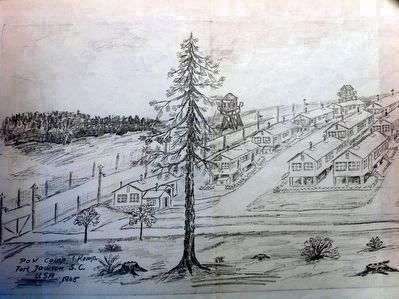
Photographed By Walter Hofmann, 1945
5. World War II POW Camp, Fort Jackson, South Carolina
This drawing was made by Walter Hofmann, a prisoner of war at the camp, during his stay. It belies the marker's assertion that the prisoners were housed in tents. Perhaps it started as a tent camp, and was upgraded to wood buildings as the war progressed.
"Aiken continues to capture history," Levy said. "It gives it a different place. Did any of them come back after the war (World War II)? They weren't mistreated here but they were POWs."
The Murder
On April 6, 1944, Cpl. Horst Gunther, 24, was found hanging by a noose from the cross-arm of a telephone pole. His death was initially ruled a suicide.
But it was later discovered Gunther had been denounced as a "traitor to the Reich and to the fuehrer" by his fellow inmates, according to a newspaper article. Prisoners claimed he was traitor because he liked jazz music and spoke in favor of America. Reports indicate Sgt. Eric Gauss and Private Rudolph Straub, with four others, attacked Gunther. Skinner's story reports the unidentified four restrained Gunther while Gauss and Straub strangled him with rope, but newspaper articles report Gunther was beaten to death.
Gauss and Straub were later found guilty and convicted of Gunther's murder during a court martial at Fort McPherson in Georgia. Both were sentenced to death by hanging.
Gauss
and Straub were hanged on July 14, 1945 at Fort Leavenworth in Kansas, according to Skinner.
— Submitted January 9, 2011, by Brian Scott of Anderson, South Carolina.
Credits. This page was last revised on October 13, 2020. It was originally submitted on October 2, 2010, by Mike Stroud of Bluffton, South Carolina. This page has been viewed 6,027 times since then and 177 times this year. Photos: 1, 2, 3, 4. submitted on October 2, 2010, by Mike Stroud of Bluffton, South Carolina. 5, 6, 7. submitted on October 21, 2015, by J. J. Prats of Powell, Ohio.
